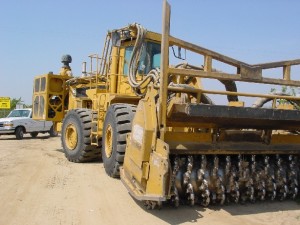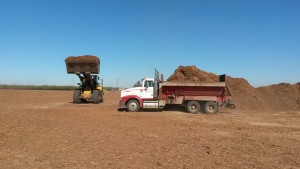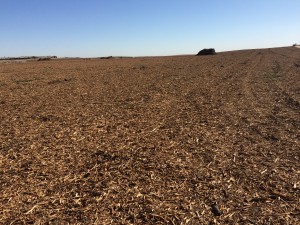Written by Brent Holtz (UCCE San Joaquin) and David Doll (UCCE Merced)
You may have heard the news—co-generation plants are limiting the amount of chipped biomass they are accepting. This is reducing the rate in which old orchards are removed, impacting the orchard redevelopment process.

The soil incorporation of chipped or ground almond, peach, plum, or cherry trees during orchard removal could provide an alternative to co-generation plant or burning and could add valuable organic matter to our San Joaquin Valley soils. Traditionally, many growers feared that wood chips or grindings would stunt tree growth by either allelopathic compounds or reduced nitrogen availability due to the high carbon to nitrogen ratio. Interestingly enough, recent research has found this not to be true if the ground material is spread across and incorporated into the soil
In 2008, University of California Farm Advisors and a USDA Plant Pathologist undertook a project at the UC Kearney Research and Extension center to compare the grinding of whole trees with burning as a means of orchard removal. Twenty-two rows of an experimental orchard on nemaguard rootstock were used in a randomized blocked experiment with two main treatments, whole tree grinding and incorporation into the soil with ‘The Iron Wolf,’ a 50-ton rototiller, versus tree pushing and burning. We examined second-generation orchard growth and hypothesized that soils amended with woody debris will sequester carbon at a higher rate, have higher levels of soil organic matter, increased soil fertility, and increased water retention. Second generation almond trees (Nonpareil, Carmel, Butte) were planted in January/February 2009.
The whole tree grinding did not stunt replanted tree growth. In 2015, Greater yields were ultimately observed in the grind treatment, when compared to the burn (previous year’s yields were similar). In 2013, 2014, and 2015, soil analysis revealed significantly more calcium, manganese, iron, magnesium, boron, nitrate, copper, electrical conductivity, organic matter, total carbon, and organic carbon. Soil pH was significantly reduced in the grind treatment plots. Annual leaf petiole analysis showed significantly greater levels of nitrogen, potassium, phosphorus, manganese, and iron from trees growing in the grind treatment, while magnesium and sodium levels were significantly less. Field observations found less salt burn in ground plots and less wilting when water was cut-off for harvest, suggesting an increase in cation exchange and water holding capacity. Please see this poster and article written on the project.

While we are waiting on the return of the Iron Wolf to California, growers still have an option of orchard incorporation. Currently, several growers are using tub grinders to chip up their orchards then spreading the chips using spreading services or large manure spreaders. When all the chips were spread back onto the soil surface it was approximately 1-2″ thick. The material was spread prior to orchard ripping, tilling, and discing, which will help to incorporate the chips into the soil. The chips from the tub-grinding are actually smaller than what we found with the Iron Wolf, suggesting that incorporation and breakdown within the soil should be easier and faster.
There is, however, an extra cost to doing this. Since the wood chips are not being sold to the co-generation plants, this money no longer helps subsidize the grinding of the orchard. Typically, the wood chips are sold to the co-generation plants at around $40/ton. Within most orchards, this means that each ton of biomass is valued around $25-35/ton with transportation costs are removed. We have talked with several growers that have paid from $200-300 per acre to keep the chips (~ 100 tons of biomass/acre), and around $150-200/acre to spread. This was on top of the grinding fees for orchard removal. Within our trial, we paid approximately $800 per acre to have the Iron Wolf grind up trees in our trial (that price would have been reduced if we had more acreage). This suggests that both methods are comparable in cost, but may be less depending on on-site equipment and labor availability.

Though the cost initially appears prohibitive, the ultimate value of returning all that organic matter to your soils (~100 tons/acre) will be realized in increased soil fertility and productivity in your next orchard.


Steve Dampier
November 25, 2015Do you think it’s possible that burying the wood from entire orchard might create a favorable environment for Armillaria Mellea?
David Doll
November 30, 2015Steve,
We dont know for sure. Armillaria does live on dead wood, but often it colonizes roots. In Armillaria affected orchards, it is difficult to remove all of the roots, so there probably is ample inoculum in the field for future infections. There may be a chance tha other fungi that feed on the dead wood may out compete or inhibit growth of Armillaria, but that is also unknown. At this point, it may be best to not grind trees within Armillaria affected areas. In these areas, it would be best to do what is possible to reduce movement of contaminated soil or roots.
David